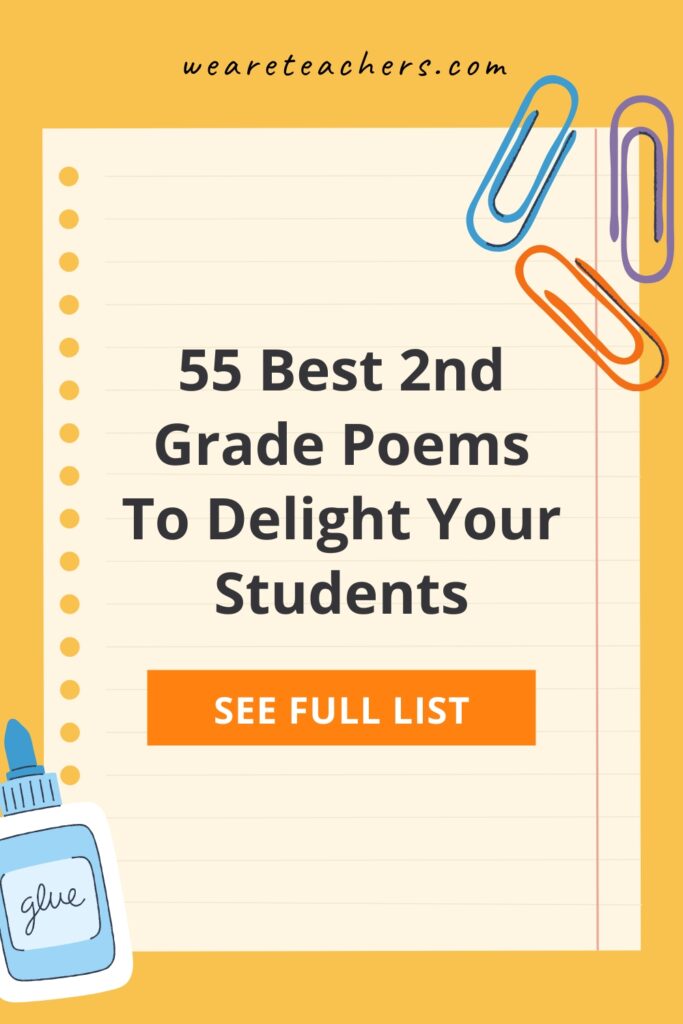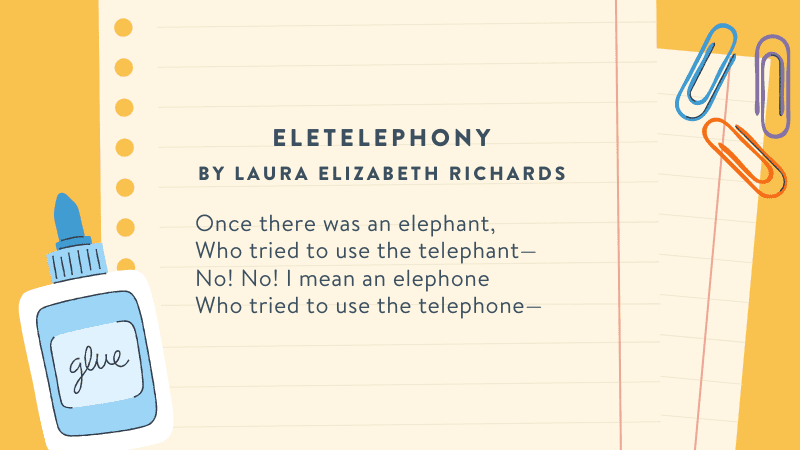One of the best ways to teach students the power of words is through poetry. This list of fun poems will engage 2nd graders in serious, silly, and sentimental poems they can analyze and learn from.
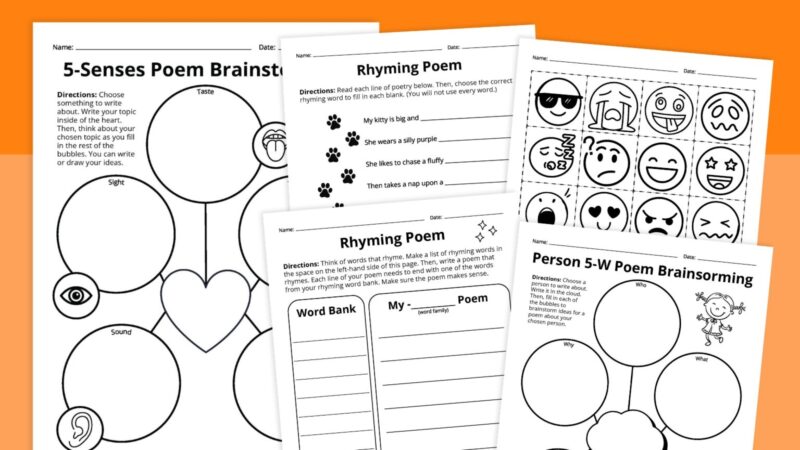
FREE PRINTABLE
Poetry Worksheet Bundle
Click the button below to receive our bundle of free poetry worksheets for grades K-2.
1. Second Grade Superstars by Anonymous
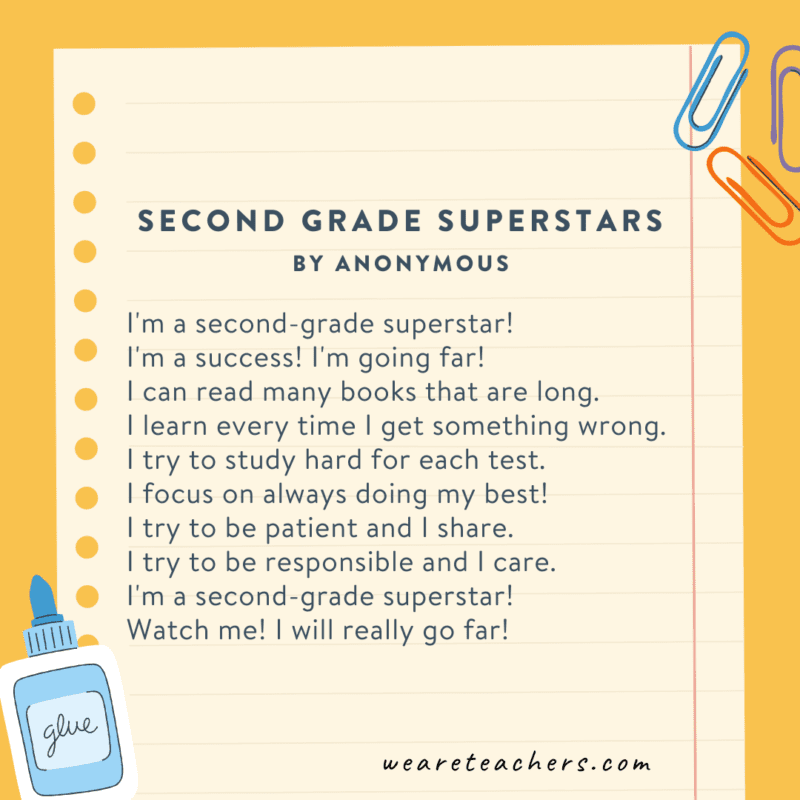
Themes: School, Confidence
Literary Devices: Repetition, Punctuation
Use this poem at the beginning of the school year to engage students in thinking about the year ahead. It also has rhyming lines that students can identify to start to talk about structure.
2. The Porcupine by Ogden Nash
Any hound a porcupine nudges/Can’t be blamed for harboring grudges
Themes: Humor, animals
Literary Devices: Rhyme
This silly poem about a porcupine is a great one for vocabulary (grudge, nudge). Discuss how the poet creates a small scene in just four lines.
3. At the Zoo by William Makepeace Thackeray
First I saw the white bear, then I saw the black
Themes: Animals
Literary Devices: Repetition, Rhyme
Repeated lines and rhyming words make this poem a great one to read aloud. See if students can read it without their voices moving along with the cadence.
4. Mary’s Lamb by Sarah Josepha Hale
Mary had a little lamb/It’s fleece was white as snow
Themes: Animals
Literary Devices: Narrative, Rhyme
Nursery rhymes are a great way to introduce kids to poetry using familiar rhymes. In “Mary’s Lamb” you can teach one, two, or even three stanzas quite easily.
5. I Taught My Cat To Clean My Room by Kenn Nesbitt
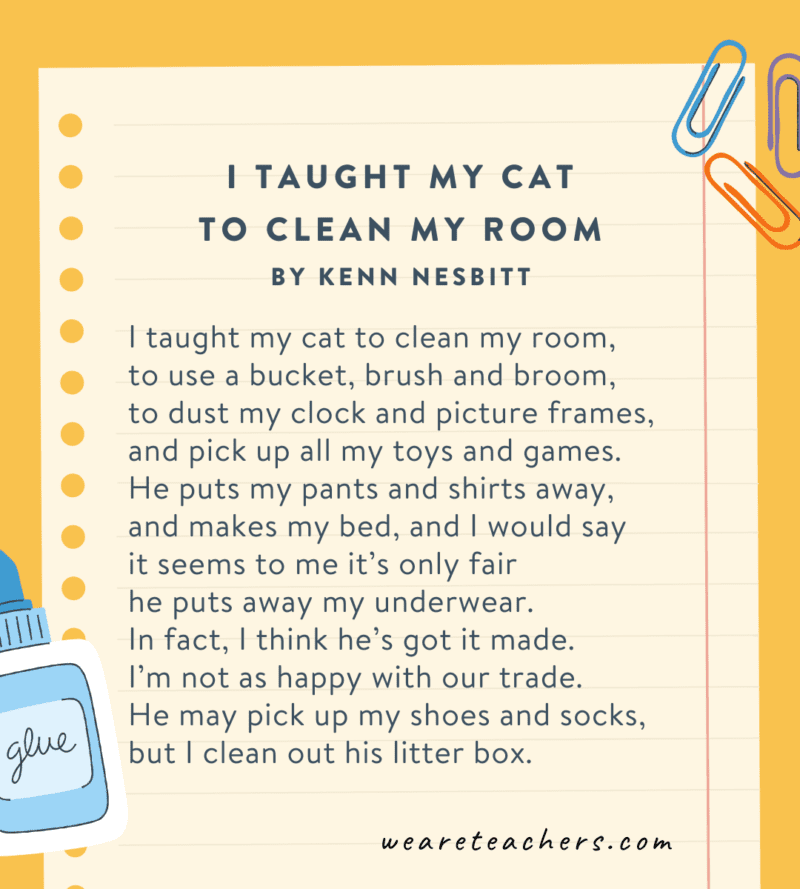
Themes: Animals, Responsibility, Humor
Literary Devices: Rhyme
This silly poem is a great entry point to poetry because students can analyze the poem for rhyming words and syllables, and they can analyze what’s happening, including the joke at the end.
6. A Silly Crow by Andrea Crawford
Here is a very silly crow/Upon her head there is a bow
Themes: Humor, animals
Literary Devices: Rhyme
Use this poem to inspire students to write their own poem about one thing. They can start their poems with “Here is a very …” and go from there.
7. Snakes by Mariah Deitrick
A snake can glide from side to side/They’re really long and hard to hide
Themes: Animals
Literary Devices: Rhyme
What nonfiction facts are incorporated into this poem? Students can read it and underline the facts that the poet included and how they incorporated some jokes too.
8. An ancient pond! by Matsuo Basho
An ancient pond!/With the sound from the water/Of the frog as it plunges in
Themes: Animals
Literary Devices: Enjambment (continuing sentences)
Such a short poem, but it makes a splash! Talk about the vocabulary (ancient, plunges). Then, talk about what sound the poet is writing about.
9. The Crocodile by Lewis Carroll
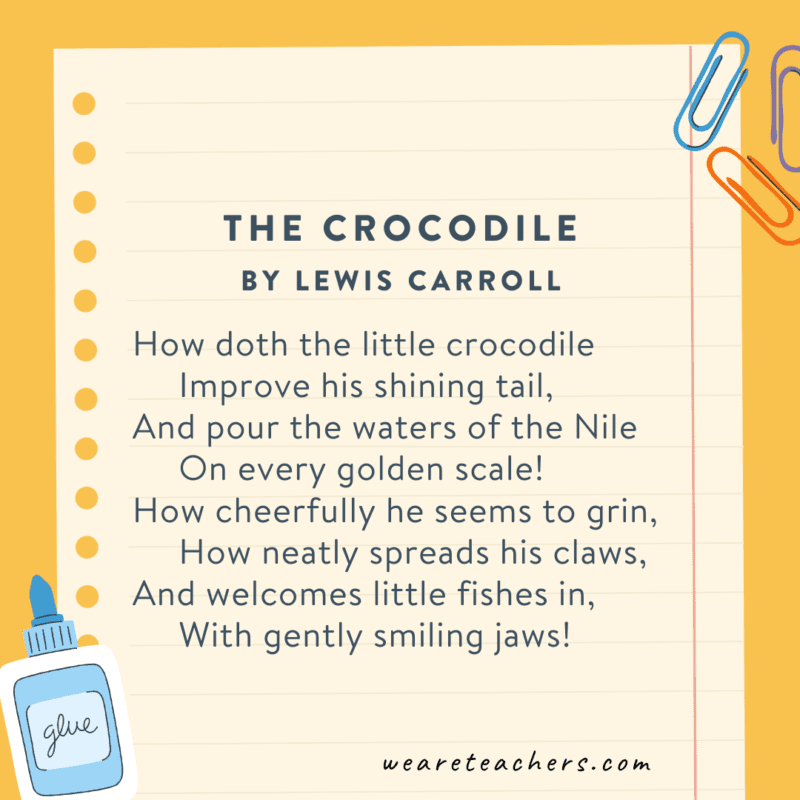
Themes: Animals, Humor
Literary Devices: Rhyme
Poetry wouldn’t be the same without Lewis Carroll. This poem is a fun one to read aloud, to show students how, even if the poem uses some words we don’t (“doth”), we can still understand a lot from the tone and atmosphere the poem creates.
10. My Dog Does My Homework by Kenn Nesbitt
My dog does his homework/at home every night
Themes: Pets, Humor
Literary Devices: Rhyme, Enjambment
You don’t have to wait until a student says their dog ate their homework to bring this poem into your classroom. Brainstorm all the problems with having your dog do your homework, then review the poem and talk about which problems made it into the poem.
11. My Big Fat Cat by Christian M. Mitewu
I own a big fat cat/The fattest for miles around
Themes: Animals, Humor
Literary Devices: Hyperbole, Rhyme
Another homework poem, read this one alongside “My Dog Does My Homework,” and talk about how two poets approached the same subject.
12. The Parakeets by Alberto Blanco
They talk all day/and when it starts to get dark/they lower their voices
Themes: Pets, Human nature
Literary Devices: Rhyme, Punctuation
Teach students how authors create tiny scenes with each stanza of this poem about a talkative bird.
13. The Pasture by Robert Frost
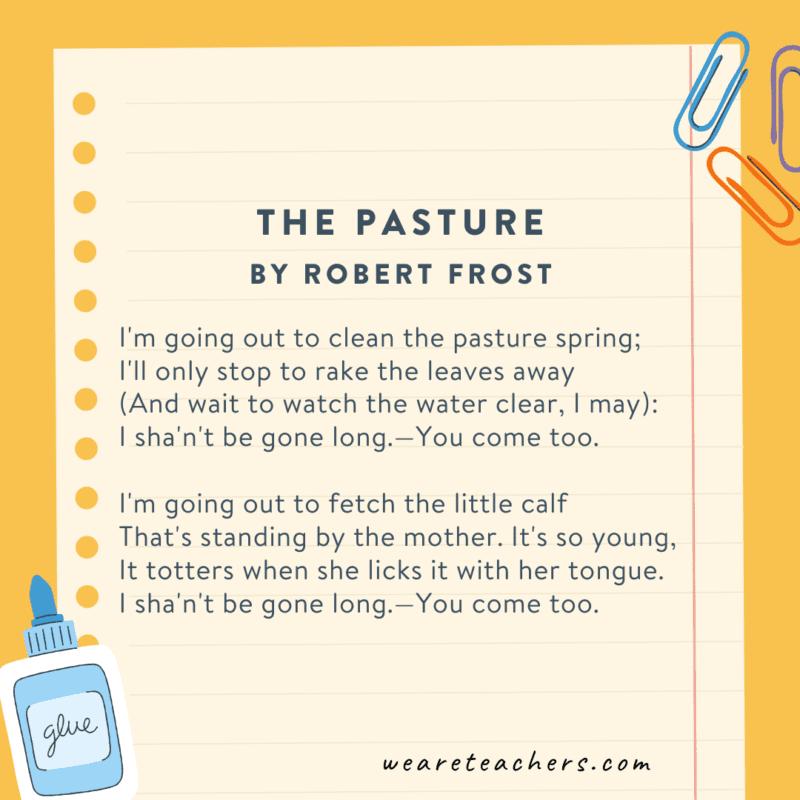
Themes: Nature
Literary Devices: Punctuation, Enjambment
Robert Frost isn’t just for older readers. This inviting poem about cleaning the pasture and bringing in a calf is a great poem to read aloud, or have higher readers read and analyze it.
14. How Not To Have To Dry the Dishes by Shel Silverstein
If you have to dry the dishes/(Such an awful boring chore)
Themes: Responsibility, Humor
Literary Devices: Rhyme, Punctuation
This poem’s structure, with the use of parentheses, is worth talking about. How do the parentheses add meaning? How does Shel Silverstein use them as an aside to the reader?
15. The Goops by Gelett Burgess
The meanest trick I ever knew/Was one I know you never do
Themes: Humor, Manners
Literary Devices: Rhyme
The Goops are a bunch of children that make mischief your students would never dream of! The Goop poems, like this one, are great for talking about the imagination that we can bring to poetry.
16. If I Were in Charge of the World by Judith Viorst
If I were in charge of the world/I’d cancel oatmeal
Themes: Imagination
Literary Devices: Repetition, Rhyme
With a repeated first line, “If I were in charge of the world …,” children’s author Judith Viorst imagines what she could do. After students read Viorst’s ideas, what would they do if they were in charge? Write a class poem with the same beginning line.
17. My Best Friend by Abby Jenkins
Black and white/Thick and furry/Fast as the wind
Themes: Pets
Literary Devices: Simile, Rhyme
This poem describes a furry best friend without ever naming what it is. What clues and details does the poet reveal that help the reader know what they’re talking about? Can students write a poem about something they love without mentioning the actual object of their affection?
18. Eletelephony by Laura Elizabeth Richards
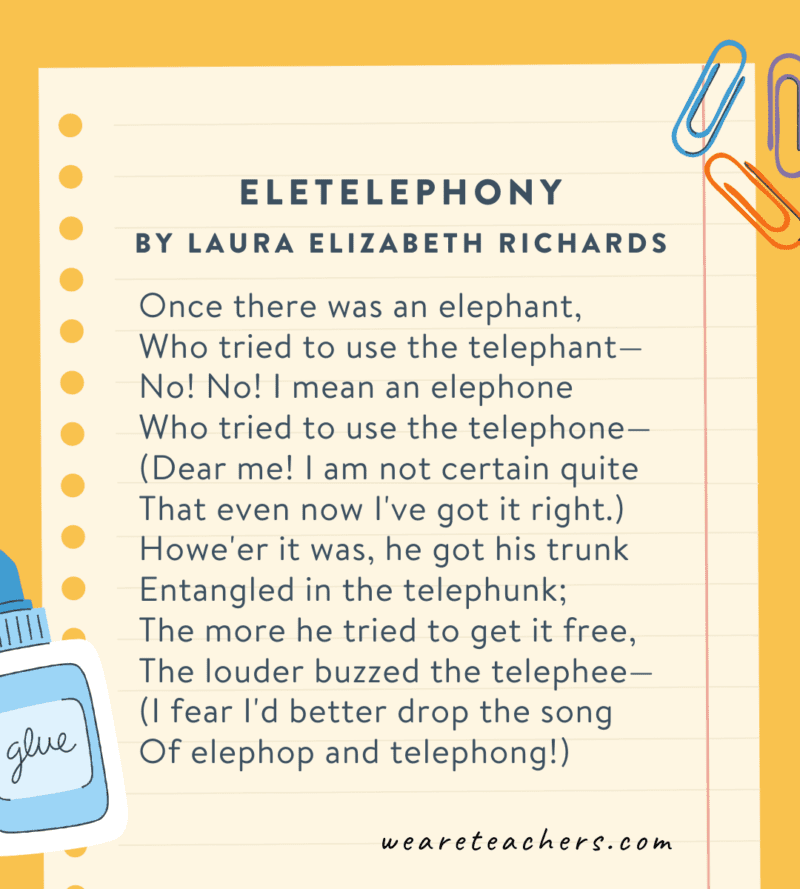
Themes: Animals, Absurdity
Literary Devices: Made up words, Rhyme
This fun-to-read-aloud poem plays with words in fun ways. Read it aloud during whole-group work, or challenge your higher readers to read it aloud in a poetry slam.
19. The Forest by Annette Wynne
The forest is a town of trees/Where they live quite at their ease
Theme: Nature
Literary Devices: Metaphor
Use this poem to teach ways that poets use comparisons to describe things, like a “town of trees.”
20. The Butterfly Ballad by Guy Belleranti
Butterfly starts as an egg/as an egg, as an egg
Themes: Nature, Life Cycle
Literary Devices: Repetition, Rhyme
Repeated words and phrases make this poem a “ballad” about the life cycle of a butterfly.
21. I Made a Meme This Morning by Kenn Nesbitt
I made a meme this morning/I posted it online
Themes: Modern life, Technology
Literary Devices: Rhyme
A fun poem about technology and internet literacy. Read this one to talk about what students should be thinking when they post online and capitalize on the rhythm to help students remember to think before they post.
22. In cold spring air by Reginald Gibbons
In cold/spring air the/white wisp–
Themes: Nature, Seasons
Literary Devices: Enjambment, Structure
The poet creates an interesting structure with their words in this poem. Talk about how the way the words are organized makes students think about the air and wisps of wind.
23. The Storm by Dorothy Aldis
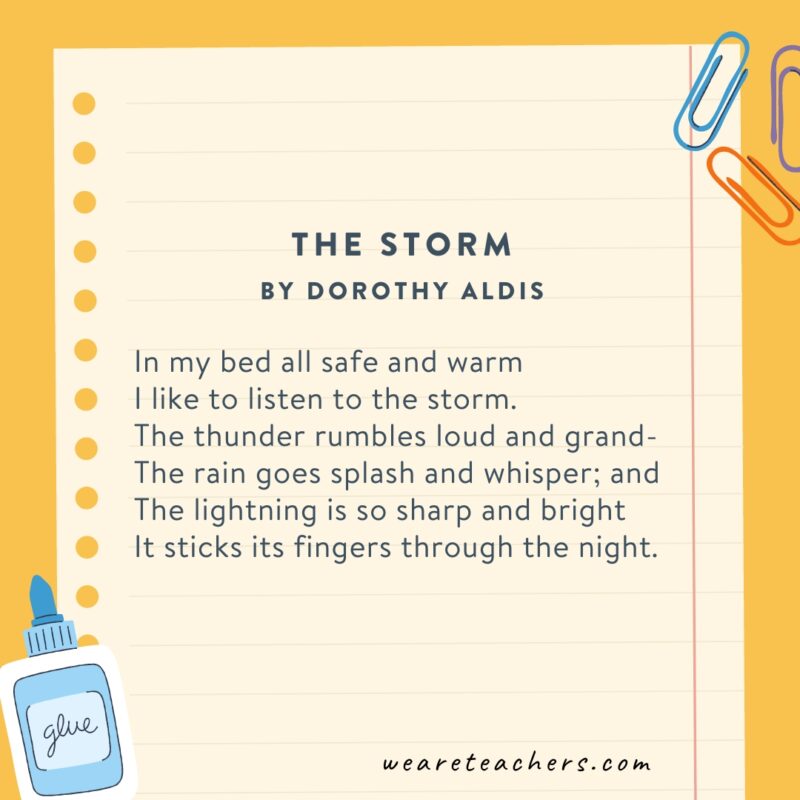
Themes: Nature, Weather
Literary Devices: Rhyme
Descriptive words and phrases make this depiction of experiencing a storm take the reader right to the scene. Talk about the details that make the scene come to life.
24. Seashell by James Berry
Shell at my ear/Come share how I hear
Themes: Nature
Literary Devices: Personification, Simile
Study how the poet uses metaphor and description to explain what he hears inside a seashell.
25. A Jelly-Fish by Marianne Moore
Visible, Invisible/A fluctuating charm
Themes: Animals
Literary Devices: Structure
Look at images of jellyfish and read this poem. Talk about how Marianne Moore describes the jellyfish and how the poem might be written using more modern language.
26. Rain Sound by Lillian Morrison
At first its like drumming/as it patters down and stops
Themes: Rain, Nature
Literary Devices: Personification, Metaphor
This poem is great for introducing metaphors, like rain drumming and then sounding like an animal.
27. Nicknames by Kenn Nesbitt
My aunt calls me “Elizabeth”/My grandma calls me “Liz”
Themes: Names, Humor
Literary Devices: Rhyme, Contrast
A fun poem about all the nicknames for Elizabeth, and all the ways one kid is still called the wrong name. This is a fun poem to talk about names before students write poems about their own names and nicknames.
28. Dirt on My Shirt by Jeff Foxworthy
There’s dirt on my shirt/And leaves in my hair
Themes: Nature, Play
Literary Devices: Rhyme
The poet describes playing outside in this short poem. Students can talk about the way the poet describes playing outside and what he likes about the experience.
29. Tiger by Valerie Worth
The tiger/Has swallowed/a black sun.
Themes: Animals
Literary Devices: Enjambment, Imagery
This poem describes creative ways the tiger got his stripes and black eyes. Use it to inspire students to think about other ways animals could get their unique features. Then, they can write poems about animals they like.
30. Your Best by Barbara Vance
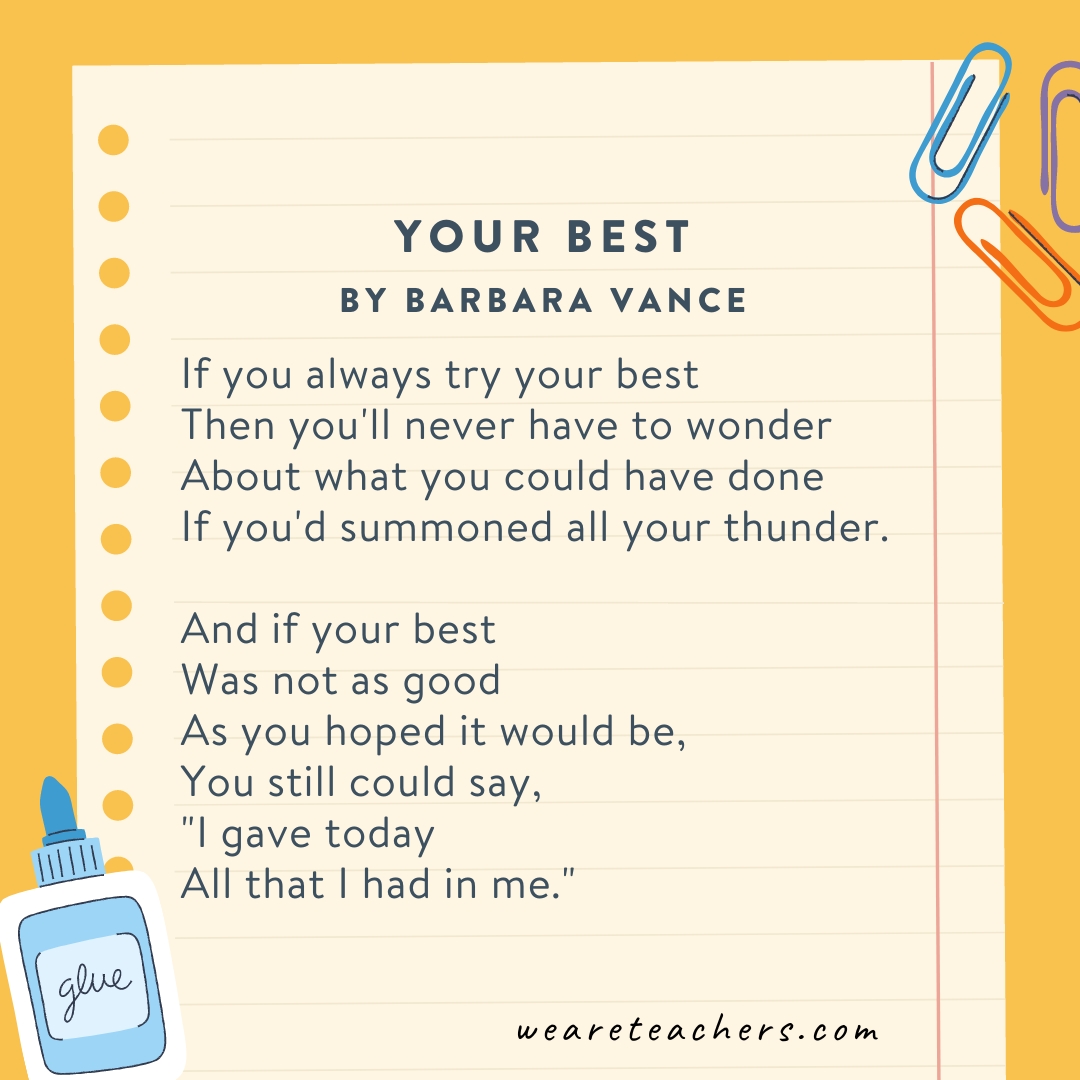
Themes: Encouragement
Literary Devices: Rhyme
This is a great poem to start the year or week with (or to read after a school break). Students can reflect on the message about doing your best and trying again.
31. Walking With My Iguana by Brian Moses
I’m walking/with my iguana.
Themes: Humor, Imagination
Literary Devices: Repetition
A silly poem about an iguana going for a walk. How does the poet combine factual information with silly details to create the story?
32. Magic Carpet by Shel Silverstein
You have a magic carpet/That will whiz you through the air
Themes: Humor
Literary Devices: Rhyme
It’s not a poetry unit without Shel Silverstein. In this case, he imagines what could be with an ordinary carpet. What could students imagine for your class rug after reading this poem?
33. The Owl and the Pussy-Cat by Edward Lear
The owl and the pussy-cat went to sea/In a beautiful pea-green boat
Themes: Adventure
Literary Devices: Rhyme, Narrative
This is a classic poem that students may have already heard. It’s a great introduction to poems that tell a longer, shall we say, epic story.
34. The Tyger by William Blake
Tyger, Tyger, burning bright/In the forests of the night
Themes: Power of Nature
Literary Devices: Imagery, Rhetorical questions
This poem has advanced vocabulary (symmetry, immortal), and you can use one or more stanzas to teach students new words and talk about how the tiger was created. (Read it with “Tiger” by Valerie Worth to get two ideas on how tigers came about.)
35. The Jabberwocky by Lewis Carroll
‘Twas brillig and the slithy toves/Did gyre and gimble in the wabe
Themes: Hero’s Journey, Imagination
Literary Devices: Made up language, Alliteration
“The Jabberwocky” is an advanced poem if you try to read and analyze it. But it’s a great poem to just listen to. Read this one aloud and ask students what they think about the energy and tone of the poem. It’s anything but serious.
36. The Quangle Wangle’s Hat by Edward Lear
On the top of the Crumpety Tree/The Quangle Wangle sat
Themes: Humor, Story
Literary Devices: Narrative, Hyperbole
Similar to “The Jabberwocky,” this poem is all about read-aloud. Read it and listen for the tone and how the silly words turn the poem into a fun auditory ride.
37. When the Teacher Isn’t Looking by Kenn Nesbitt
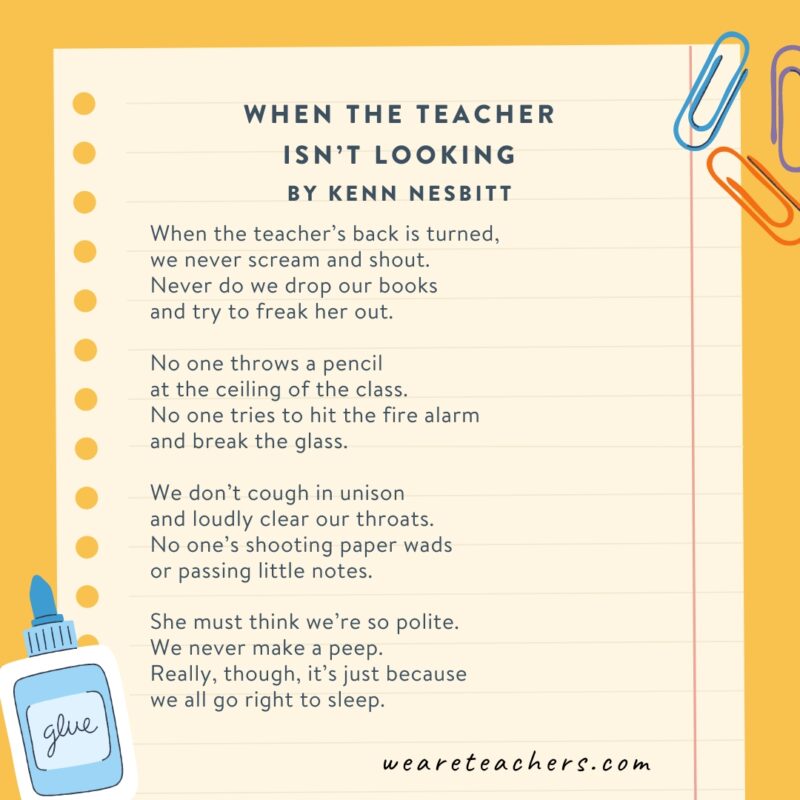
Themes: School, Humor
Literary Devices: Rhyme
Start the year with this poem, or read it as an instructional message before you take time off and students will have a substitute.
38. The Tale of Custard the Dragon by Ogden Nash
Belinda lived in a little white house/With a little black kitten and a little gray mouse
Themes: Animals, Imagination
Literary Devices: Simile, Rhyme
Another poem that tells a longer story. Read this poem and talk about what’s happening in each stanza.
39. For Sale by Shel Silverstein
One sister for sale!/One crying and spying young sister for sale
Themes: Sibling rivalry, Humor
Literary Devices: Rhyme, Questions
This is a quintessential Silverstein poem, with a relatable topic and fun approach. Students can talk about what is happening and the joke Silverstein has woven into the words.
40. The Land of Counterpane by Robert Louis Stevenson
When I was sick and lay a-bed/I had two pillows at my head
Themes: Imagination
Literary Devices: Rhyme
“The Land of Counterpane” has a structure that 2nd graders can analyze (AABB) and is about a topic that they will find familiar: a day spent home sick in bed.
41. Adventures of Isabel by Ogden Nash
Isabel met an enormous bear/Isabel, Isabel didn’t care
Themes: Adventure, Bravery
Literary Devices: Repetition, Imagery
A fairy tale within a poem, read “Adventures of Isabel” to describe literally what happens, and to talk about how the poem progresses from one silly scene to another.
42. Homework! Oh, Homework! by Jack Prelutsky
Homework! Oh homework!/I hate you. You stink.
Themes: Homework, Humor
Literary Devices: Hyperbole, Rhyme
What is elementary school poetry without Jack Prelutsky? “Homework! Oh Homework!” is a great way to start students on odes. They can read this ode to poetry, and write about something they either love or hate as much as Prelutsky hates homework.
43. Recipe for a Hippopotamus Sandwich by Shel Silverstein
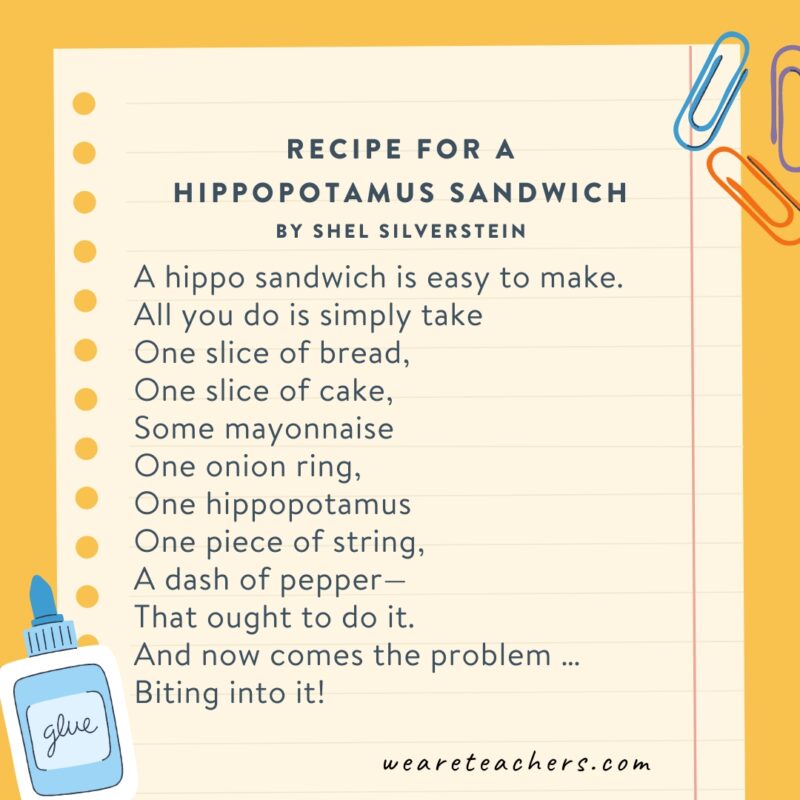
Themes: Humor, Food
Literary Devices: Repetition, Rhyme
A hippo sandwich is classic Silverstein. Students can read this poem and draw an illustration to go with it to show how they interpret the poem.
44. Wynken, Blynken, and Nod by Eugene Field
Wynken, Blynken and Nod one night/Sailed off in a wooden shoe
Themes: Adventure, Nighttime
Literary Devices: Rhyme, Repetition
This is another poem that students may be familiar with from preschool or nursery rhyme readings. It’s also an epic tale of three kids who sail off in a wooden shoe. Approach this poem as the story of a journey. How does the poet create the nighttime atmosphere and events along their journey?
45. The Duck and the Kangaroo by Edward Lear
Said the duck to the kangaroo/’Good gracious, how you hop!’
Themes: Animals
Literary Devices: Narrative, Rhyme
This poem imagines interactions between different animals. Use one or more stanzas and read the poem to capture the cadence and the silly interactions between animals.
46. Casey at the Bat by Ernest Lawrence Thayer
The outlook wasn’t brilliant for the Mudville nine that day
Themes: Baseball, Defeat
Literary Devices: Imagery, Rhyme
This poem is perfect for kids who are obsessed with baseball, or for kids who think poetry is only about animals and seasons. “Casey at the Bat” is the epic poem about a baseball team, with lots of baseball vocabulary and scene building.
47. The Purple Cow by Gelett Burgess
I never saw a purple cow/I never hope to see one
Themes: Absurdity, Humor
Literary Devices: Rhyme
This catchy poem that doubles as a rhyme is great to quickly read and analyze during morning meeting or a mini-lesson. It also has a useful moral about maintaining perspective.
48. The Duel by Eugene Field
The gingham dog and the calico cat/Side by side on the table sat
Themes: Humor, Imagination
Literary Devices: Rhyme, Narrative
This poem is written in older English, so it’s good for a read-aloud. Talk about the vocabulary (duel, gingham, slept a wink), then talk about what’s happening in each stanza.
49. Sarah Cynthia Sylvia Stout Would Not Take the Garbage Out by Shel Silverstein
Sarah Cynthia Sylvia Stout/Would not take the garbage out/She’d scour the pots and scrape the pans
Themes: Responsibility, Humor
Literary Devices: Alliteration, Rhyme
One of the best Silverstein poems (in our opinion), this poem is silly, fun, and builds to an important moral about responsibility. It also uses alliteration to reinforce the read-aloud-ability typical of Silverstein’s poems.
50. The Spider and the Fly by Mary Howitt
“Will you walk to my parlor?” said the Spider to the Fly.
Themes: Vanity, Flattery
Literary Devices: Personification, Alliteration
The interaction between a spider and a fly creates a macabre poem about succumbing to flattery and vanity. Read it at Halloween time, or when you’re talking about dialogue and how authors use dialogue to move stories forward.
51. The Tale of the Sun and the Moon by Kenn Nesbitt
The sun was in his bathing suit/the moon in her pajamas
Themes: Relationships, Friendship
Literary Devices: Personification
This poem is a great example of personification. The sun and moon are both personified and described doing various activities around the house. Talk about why a poet would personify the sun and moon. How does it help communicate the poem’s message?
52. Clouds by Christina Rossetti
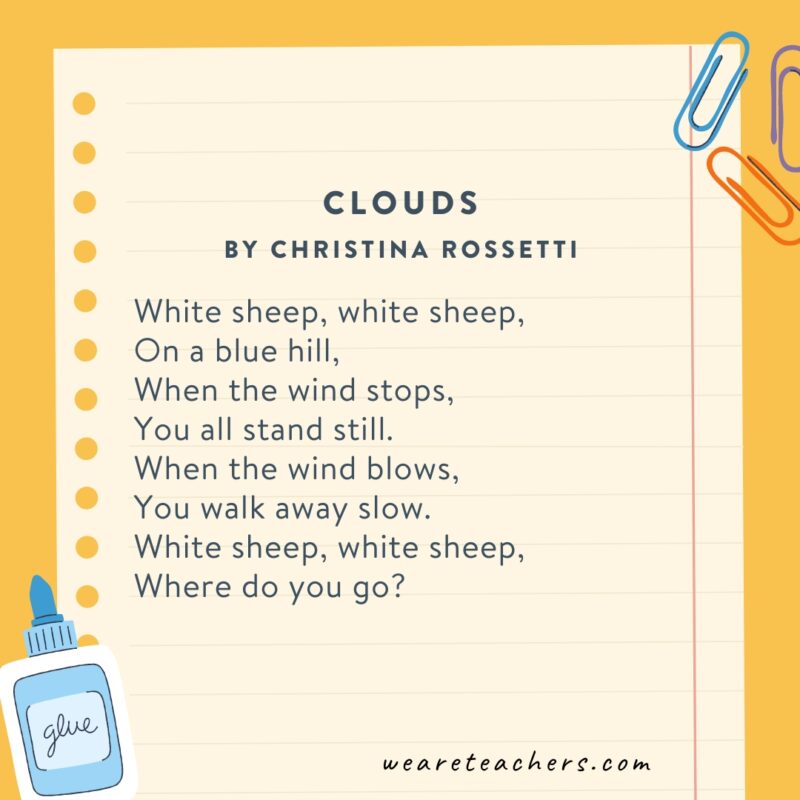
Themes: Opportunity
Literary Devices: Rhyme, Repetition
Active poems like this are great to use during circle time. Have students listen to the poem and pretend they are the sheep walking or standing still. With older students, talk about what themes are in the poem; is this poem just about sheep or is the poet making a broader point?
53. The Acrobats by Shel Silverstein
I’ll swing/by my ankles/She’ll cling/to your knees
Themes: Fun, Humor
Literary Devices: Structure, Rhyme
A great example of how one rhyming sound can be carried through a poem (in this case the long ‘e’ sound in sneeze and breeze).
54. When Tillie Ate the Chili by Jack Prelutsky
When Tillie ate the chilli/She erupted from her seat
Themes: Humor
Literary Devices: Hyperbole, Rhyme
This poem is an introduction to hyperbole, with dramatic descriptions of what happens to Tillie after she eats a bowl of spicy chili and “erupts.”
55. The Crocodile’s Toothache by Shel Silverstein
The crocodile/went to the dentist/And sat down in the chair
Themes: Humor, Absurdity
Literary Devices: Narrative
A short story in a stanza, read this poem and talk about how Silverstein builds suspense from the first line to the last.
Get my free poetry worksheet bundle!
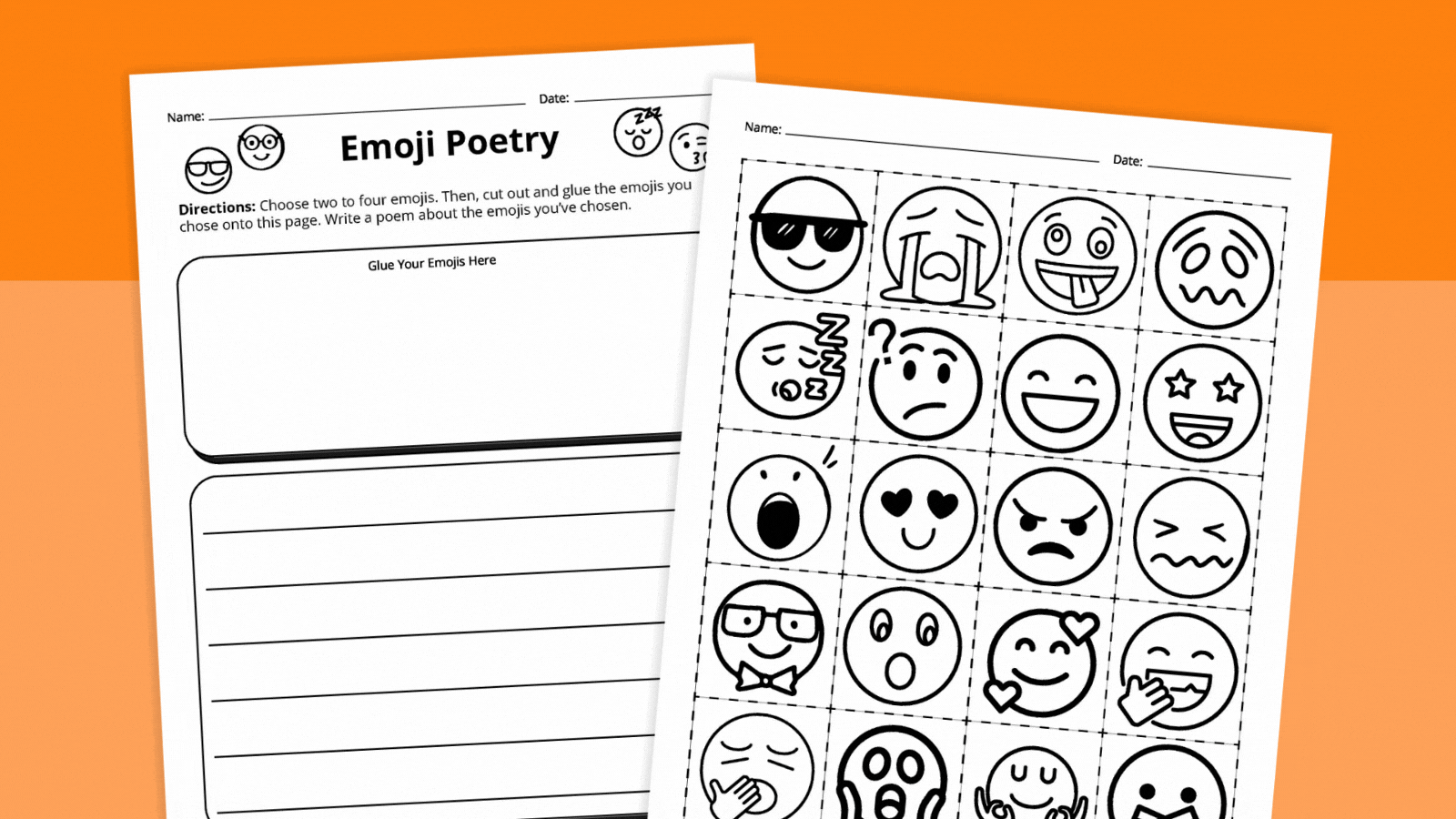
Click the button below to receive our printable poetry worksheets and activities to share with your class. It’s perfect for grades K-2.
If you enjoyed these poems for 2nd graders, be sure to subscribe to our newsletters so you can get our latest poetry recommendations.
